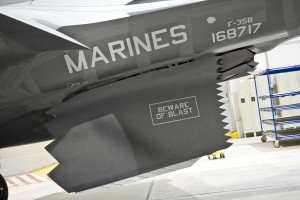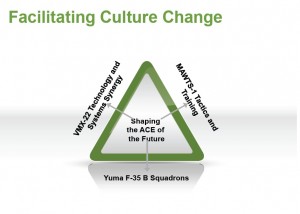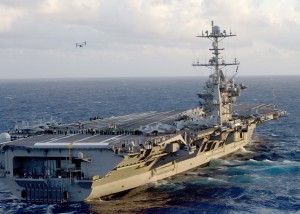2012-12-05 Second Line of Defense has provided significant coverage of the Osprey and the F-35B and their impact on the evolution of the USMC and of the role of air systems in the evolution of combat operations.
Surprisingly, or perhaps not so, there was little national press presence at the arrival of the F-35 at Marine Corps Air Station Yuma this month.
With all the words written about the F-35, it is interesting to note as the plane becomes an operational reality, there are very few words about that phenomenon.
For the Marines, the linkage of the F-35 with the Osprey and other air and ground elements is re-shaping their basic approach and combat power of the MAGTF.
In a discussion with the former Deputy Commandant of Aviation, Lieutenant General George Trautman, this evolution was discussed. It is important to note that several years prior to the recent Yuma events, the USMC leadership had set in motion ways to leverage the new technologies.
In other words, leadership matters in shaping the Cultural Revolution associated with the Osprey and the F-35.
The revolution is not concomitant with simply buying and introducing new technologies or platforms but is rooted in changing operational behavior and thinking, which the new technologies allow.
And reciprocally, such changed behavior will shape the evolution of the platforms and technologies.
This will be especially true of a software upgradeable aircraft like the F-35.
SLD: You attended the Yuma ceremonies. What did they mean to you?

Trautman: The Marine Corps has been looking forward to the arrival of the F-35B since the mid-1990’s. We are talking about many years of a vision that hasn’t quite come to full fruition yet, but certainly the standup of the first operational squadron is a significant milestone for Marine aviation.
For me, it was incredibly gratifying to be on the MCAS Yuma flight line when we flew in the first two F-35B’s. As you recall, it was just two years ago that the program was under constant attack by those who didn’t quite grasp that the typical challenges of engineering in the early stages of a developmental program have to be dealt with through patience and quiet resolve.
The fact that the Commandant was there, along with Senator McCain and the Under Secretary of the Navy, made the ceremony special. Although there are still challenges ahead, each of the speakers noted that the program is now on solid footing and they expressed optimism about the way ahead.
Frankly, the success we have had is not surprising to me. There wasn’t a day in my tenure as the Deputy Commandant for Aviation that I didn’t believe that we would arrive at the place that we are today. That optimism came from the fact that this is the right thing to do for our Marine Corps and the right thing to do for our nation.
As I sat on the flight line and looked around me, I saw that we had all the right people in the audience. We had operators. We had planners who think about future tactics. We had engineers. We had people from the systems command, the material command and the test community. We had all of the key leaders from industry. And, we also had the people who were responsible for the incredible infrastructure that has been built at MCAS Yuma over the past few years to accommodate 5th generation operations.
So, we had all the pieces of the puzzle that have been responsible for delivering the world’s finest strike fighter to the United States Marine Corps. It was certainly a fitting occasion for celebration. We’re now on the cusp of setting the course for the next 50 to 75 years of fixed wing tactical aviation for the Marine Corps and it’s full steam ahead.
I expect the innovation and determination of the operators to exponentially increase the pace at which this airplane now starts to evolve.
SLD: I would like to highlight something I find very innovative by the Marines, which was set in motion during your time as DCA. You are not just going to have a couple squadrons at Yuma. You’ve got the intersection with MAWTS and also the Marines are moving VMX-22 from New River.
In other words, the Marines have collocated three key elements to drive real world combat innovation associated with the aircraft.
Could you talk a little bit about the thinking that went behind setting that up and what your hopes are about that kind of collocation driving innovation?

Trautman: As I look back to the summer of 2007 when I became the Deputy Commandant for Aviation, I marvel at the prescient decisions that our F-35B planners made in the run up to our first operational squadron.
As you recall from previous conversations, one of the smarter things that we did is we took Lieutenant Colonel Chip Berke and we assigned him to an F-22 squadron at the invitation of the Air Force Chief of Staff. We put Chip there for almost three years and then we moved him down to take command of our first F-35 replacement training squadron, VMFAT-501. His experience with 5th generation operations in the F-22 informed us that the F-35 was going to require a significant adjustment in the way we train and fight our tactical fixed wing aircraft.
We knew from the beginning that we needed to focus intently on what it would take to ensure success when our first operational F-35 squadrons began to receive this game changing technology.
Of course, we handpicked the first operational squadron’s new commander along with his initial cadre of aviators, some of whom who had previous experience with F-35 operations in VMFAT-501, in order to ensure we had extremely talented individuals manning VMFA-121.
But, a key component of our decision to start out in Yuma was driven by the fact Marine Aviation Weapons and Tactic Squadron One, the world’s premier organization for the development and employment of aviation weapons and tactics, is co-located on that base. MAWTS-1 is staffed with individuals of superior aeronautical and tactical expertise who are subject matter experts in every element of the Marine air/ground task force.
In my view, some of the greatest minds in modern aviation reside in that squadron. The commander is one of the best thinkers at the colonel level in the Corps today and his team has been charged by the current Deputy Commandant for Aviation to work with VMFA-121 to speed the development of future tactics and standardization in the F-35.
These two squadrons, operating side-by-side at MCAS Yuma, are going to reap incredible dividends for Marine aviation.
But, the innovative approach to posturing F-35 for success didn’t stop there. The Marine Corps also decided to take VMX-22, our only Operational Test and Evaluation Squadron, which had previously focused solely on the V-22, and expand its operational test portfolio to include the F-35B at MCAS Yuma.
With an F/A-18 pilot now commanding the squadron, the knowledge and lessons learned in operational test of the F-35B will inform the MAWTS-1 and VMFA-121 tactical planners as they stay focus on minimizing risk and maximizing performance of the F-35B in support of the Marine Air Ground Task Force.
With squadron operators, tactical innovators and operational testers all working toward the same desired end state at MCAS Yuma, this is going to be an example of a case where the sum is greater than the collection of its parts. We just have to watch with a little bit of patience over the next year or two and I think you’ll see that we’ll reap the benefits of this decision far more than we would have if these organizations were operating at disparate geographic locations.
SLD: How will this kind of cross cutting innovation among the squadron, MAWTS and VMX-22 shape change?

Trautman: Twice a year in Yuma, Marine Aviation Weapons and Tactic Squadron One conducts a large-scale exercise with every element of Marine aviation supported by joint aviation assets gathered together for six weeks of training in the desert. That opportunity alone is going to provide VMFA-121 a chance to work side-by-side with all of the Corps’ newest aviation technologies, with the V-22 Osprey being the premier new technology, but also the UH-1 Yankee, the AH-1 Zulu, the KC-130J and our new aviation command and control system.
All these operational elements will periodically operate from Yuma with ready access to ranges located just north and east of the air base.
Your premise that we don’t know what we don’t know about this game changer called “fifth generation” is right on the mark. When young aviators, young maintainers, and young logisticians start to operate F-35 with the other elements of the MAGTF, we’re going to experience exactly what we experienced with the V-22 when they first got their hands on the Osprey. There will be an exponential increase in the innovation and thinking and utilization of these platforms in ways that the initial planners who set the program’s course never thought of before.
In fact, I anticipate F-35 sparking a 5th generation intellectual engine at Yuma that will exceed all expectations.
An added benefit, of course, will occur when the Air Force stands up their F-35 squadrons at nearby Luke Air Force Base and we both start to operate F-35’s on the ranges at Nellis. I’ll make a prediction — three years from now, no one is going to want to be caught dead or alive operating a legacy jet in battle space dominated by the F-35 Lightening II.
When I look at Marine Aviation, I’m extremely pleased with where we are today.
The V-22 Osprey does things that no airplane in the history of mankind has ever been able to do with regard to range, speed, maneuverability, and aircraft survivability — all combined with the ability to still conduct vertical landings in the objective area. The F-35B, a short takeoff and vertical landing machine with low observable characteristics, is a flying sensor that can do everything that we need it to do in ways that are simply going to change the game.
Having those two platforms side-by-side while the rest Marine aviation forms a complementary role and determining how all the pieces of aviation fit together is going to be a challenge, but its the kind of challenge that I think all Marines relish and embrace.
This is what professional aviators do.
This is what Marines do. It’s what warriors in the other services do as well and, with V-22 and F-35, we are definitely providing the tools our Marines need to move these capabilities into the next century.
For our coverage of Yuma and related matters see the following:
http://defense.aol.com/2012/11/19/the-next-century-for-marine-aviation-the-f-35b-at-yuma/
https://sldinfo.com/shaping-a-new-approach-to-combat-learning-the-role-of-the-f-35/
https://sldinfo.com/general-amos-on-the-f-35s-at-yuma/
https://sldinfo.com/mawts-and-the-yuma-f-35-squadron-evolving-capability-into-operational-reality/
https://sldinfo.com/f-35s-on-the-final-assembly-line-november-2012/
https://sldinfo.com/leveraging-the-f-35-mawts-prepares-the-pilot-of-the-future/
https://sldinfo.com/local-arizona-tv-weighs-in-on-the-yuma-f-35-squadron/
https://sldinfo.com/first-operational-f-35-squadron-ceremony-at-yuma-arizona/
https://sldinfo.com/the-f-35-squadron-at-yuma-the-next-phase-begins/
https://sldinfo.com/the-yuma-f-35-squadron-welcomes-its-first-f-35-bravo/

